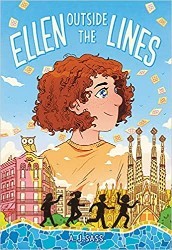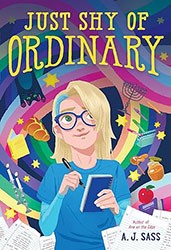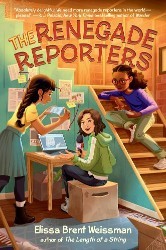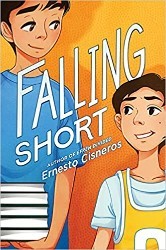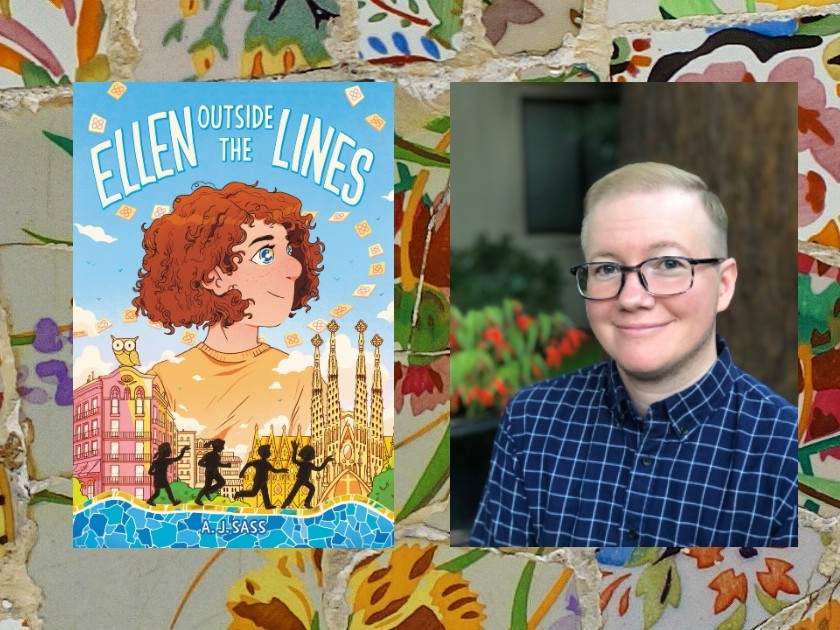
Author photo courtesy of the publisher
On the first Friday night of her school’s summer study abroad trip to Spain, Ellen Katz, the main character in my novel Ellen Outside the Lines, makes her way to her abba’s hotel room to video call her mom and celebrate Shabbat. The scene that follows is quiet; there are no major plot twists. It’s also one of my favorite scenes in the entire book because while the focus of the story isn’t strictly on Judaism, Ellen and her parents’ Jewishness is an inherent part of who they are.
This scene felt like a big deal to write in part because I hadn’t read more than a handful of portrayals of Jewish characters in middle grade books up to that point. Growing up, I read widely within a variety of age categories and genres. But most of the books I read as a kid that featured anything associated with Jews or Judaism focused on the Holocaust. This is an important topic for any young reader to learn about, without question, but I also craved more casual representation and contemporary settings.
These books may have existed when I was younger. I hope I simply missed them growing up in smaller towns throughout the Midwest and South. Maybe they simply weren’t stocked in the bookstores and libraries where I grew up because there wasn’t a large Jewish population. But even that presents a problem, in my mind. Because books can serve as mirrors to our own experiences and make us feel seen, but they’re also windows into the experiences of others, fostering empathy.
Now more than ever, we need books that serve as mirrors and windows. We need Jewish characters featured as the leads in stories where Judaism is an incidental yet still fully integrated part of the narrative. Even the smallest of nods can be essential.
That’s why my main character, Ana, and her mom are Jewish in my debut novel, Ana on the Edge. It’s certainly not the focus in a story about a competitive ice skater learning to embrace the fact that she’s nonbinary, but the representation exists in small ways that are meaningful to me as a nonbinary Jew. As Ana learns more about her identity, she begins to wonder how her role might change when she comes out to the members of her community. Will she still have a bat mitzvah if she isn’t a girl? It’s a little nod to Jewish readers, and hopefully some food for thought for those who aren’t.
In my sophomore novel, Ellen Outside the Lines, there is a larger focus on Jewish representation. Ellen’s family observes Shabbat every week, her mother is a cantor at their temple, and her abba was born and raised in a Haredi community in Israel. The story, however, is not about Ellen and her parents being Jewish; it primarily focuses on how friendships can shift during middle school, how this can be difficult but also a natural result of growing up. Still, it felt important to highlight how a Jewish kid’s experience of studying abroad might differ from those of her non-Jewish peers.
Books can serve as mirrors to our own experiences and make us feel seen, and they’re also windows into the experiences of others, fostering empathy.
Having grown up in Israel, Ellen’s abba often addresses Ellen in Hebrew. On their flight to Barcelona, for example, Ellen’s friend, Laurel, overhears Ellen and her abba speaking Hebrew, and tells Ellen, “I adore that … It’s like you and your dad have a secret language.” Ellen adores it too. There’s joy in this moment, in sharing a language that connects many within their community. That said, I chose not to include a glossary of Hebrew words at the end of the book. It’s simply a nod to families whose makeup is similar to Ellen’s. For non-Hebrew-speakers, the meanings can be understood through the larger context of the scenes they appear within.
There were also opportunities to illustrate the challenge of keeping kosher while traveling. On Ellen’s first night in Barcelona, she and her classmates eat dinner together at their hotel, buffet-style. While waiting in line, a teenage guest in front of them recommends one food item in particular. “Try the jamón serrano,” she encourages them. “It’s a specialty.”
Ellen recognizes the word from her Spanish class and knows it’s trayf. She makes a mental note to avoid it going forward, but also wonders if her abba, who is a trip chaperone, knows that ‘jamón’ means ‘ham.’ This isn’t a major plot point, by any means, but it’s a moment I hope many Jewish readers might understand or relate to. For other readers, an invitation into the life of a character whose family’s practices might look different from their own.
A person’s relationship to and expression of their faith can differ widely, even within Judaism, so I wanted to give a little nod to that in this story, as well. Ellen is autistic and finds comfort in rules. So, when her abba seems no longer to be keeping kosher during their meals, Ellen’s anxiety rises. When Ellen finally confronts Abba about this, he tells her he appreciates that she’s trying to look after him but notes that Ellen’s mom is the more observant one.
This confuses Ellen at first. “What are you talking about?” she asks. “You, and me, and Mom, we’re all the same.”
To which her abba responds that while they are a family, they aren’t all the same. And this is a good thing. Abba goes on to share why he’s sometimes less observant than Ellen and her mom and explains that it’s up to each person to decide what’s best for them. The conversation is centered around Judaism because Ellen’s family is Jewish. Another nod, but certainly not one that’s exclusive to Jewish families.
Examples like these, as well as my favorite scene depicting a transatlantic, virtual Shabbat, are all little nods to my characters’ Jewish heritage. They’re incidental, often quiet, moments of conversation or reflection that shape and sometimes challenge my characters’ understanding of the world around them. These nods may be quiet, sometimes barely noticeable, within my middle grade novels. But given enough of them, they feel like they ultimately add up to something bigger, giving readers of all backgrounds an opportunity to see the beautiful diversity within the Jewish community. Most importantly, they can be affirming to so many young readers, letting them know there’s a place for them and their families within the pages of a novel.
A. J. Sass (he/they) is an author whose narrative interests lie at the intersection of identity, neurodiversity, and allyship. His debut novel, Ana on the Edge, was a 2020 Booklist Editors’ Choice, an ALA 2021 Rainbow Book List Top 10 for Young Readers, and a Junior Library Guild Gold Standard selection. His sophomore novel, Ellen Outside the Lines, is also a Junior Library Guild Gold Standard selection. A. J. is the co-author of Camp QUILTBAG* (Algonquin, 2023) and a contributor to the This Is Our Rainbow: 16 Stories of Her, Him, Them, And Us (Knopf Books for Young Readers) and Allies: Real Talk About Showing Up, Screwing Up, And Trying Again (DK/Penguin Random House) anthologies. When he’s not writing, A. J. figure skates and travels as much as possible. He lives in the San Francisco Bay Area with his partner and two cats who act like dogs. Follow him at sassinsf.com or @matokah on Twitter and Instagram.
